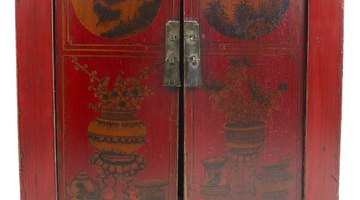Techniques for Applying Chinese Lacquer
Table of Contents
Since the fifth century BC, the Chinese have been using the sap from a native sumac tree to make a protective coating, called lacquer, for furniture and decorative items. Lacquer items were highly prized by the Chinese because of the beautiful gloss and the intensive workmanship needed to create them.

According to Karen Mazurkewich and A. Chester Ong in "Chinese Furniture: A Guide to Collecting Antiques," more than 14 different ways of applying lacquer to furniture have been identified. Chinese lacquerware is fragile, so you'll need to use special care to use it as a decorative design element.
Basic Application
To make lacquer, urushi, a milky sap, is stirred and heated, then filtered, to produce a clear material. You can apply this material over wood to enhance the wood's natural grain and color. However, most lacquer was colored black, by adding iron oxide. Red lacquer was produced with the addition of cinnabar, but its use was originally restricted to royalty. The lacquer is traditionally applied to a surface with a coarse brush. The lacquer has to cure over several days at a high relative humidity, and the surface smooths out and becomes shiny as the urushiol in the lacquer polymerizes, or links together to form long chains of atoms. In 2010, Jianrong Xia et al. reported using high-pressure mercury lamps to quickly cure lacquer with ultraviolet light.
Functional Applications
Black lacquer was used to disguise parts of furniture pieced together out of different kinds of wood. The lacquer smoothed out grain irregularities and covered over the various wood colors. It was also used to protect the undersides of pieces, protecting them from moisture and warping. The object being lacquered was often prepared by applying a primer coat of clay mixed with urushi to make a smooth surface that would cover any substrate imperfections for a very smooth lacquer finish.
Multiple Lacquer Applications
Usually many layers of lacquer would be brushed on for a durable finish. Multiple applications take a long time because of the curing time and the polishing time to bring every cured layer to a gloss before putting on more lacquer. It could take months or years to finish a multiple-layer lacquered item. An ornate kind of multiple-layer lacquerwork is called carved lacquer. Hundreds of layers of lacquer, often of different colors, were built up over a substrate such as a wooden or brass body. Artists carved elaborate designs over the lacquer surface, often taking the relief down to a layer of another color. It is estimated that at the turn of the millennium there were only 20 skilled craftsmen left who could do this type of lacquer work.
Dry Lacquer Work
This lacquer technique is used primarily to make religious statues such as Buddhas. A wooden or clay core is used as a temporary substrate over which fabric is soaked in lacquer and other materials. As many as 13 different raw materials are mixed into a paste with the lacquer. This application can be somewhat likened to paper-mache work. After the statue has been built over the substrate, the core is removed, leaving a hollow sculpture. A wooden frame is sometimes added for support.
Metal Applications
One kind of lacquer application, called makie or sprinkled picture, uses gold and silver embedded in the lacquer. Powdered and flattened metals are dusted onto or carefully embedded into a fresh wet lacquer layer. Designs can be outlined, background effects created, or an overall gilded effect achieved. Often, colored lacquer paints are used to fill in the images outlined in gold.
References
- Chinese Furniture: A Guide to Collecting Antiques; Karen Mazurkewich, A. Chester Ong.
- Bishop Museum Art Conservation Handout: Lacquer
- Techniques of Chinese Lacquer; Filippo Buonanni, Flavia Perugini
- American Chemical Society Publications: On the UV-Induced Polymeric Behavior of Chinese Lacquer
Writer Bio
Cathryn Chaney has worked as a gardening writer since 2002. Her horticultural experience working in the nursery industry informs her garden articles, especially those dealing with arid landscaping and drought-tolerant gardening. Chaney also writes poetry, which has appears in "Woman's World" magazine and elsewhere. Chaney graduated from the University of Arizona in 1992 with a Bachelor of Arts in English.
Photo Credits
- Hemera Technologies/PhotoObjects.net/Getty Images
- Hemera Technologies/PhotoObjects.net/Getty Images
More Articles



